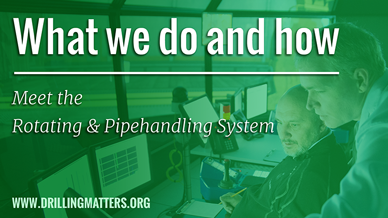
Meet the Bottomhole Assembly
The assembly of drill pipe, sophisticated instruments and pipe called the bottomhole assembly, or BHA, is the business end of the drilling rig. The BHA is attached to the bottom of a long string of pipe called the drill string. The drill string consists mainly of drill pipe, each length of which is some 30 feet long (10 meters)(, with threaded connections at each end. Drill collars are similar to drill pipe, but with thicker walls to increase pipe weight. The resulting drill string can combine hundreds of pipe lengths, reaching lengths to 30,000 feet (10,000 meters). The BHA can include numerous sophisticated downhole tools to measure wellbore properties or to steer the assembly accurately, among other applications.
The assemblage of drill bit, sophisticated instruments, and pipe called the bottomhole assembly, or BHA, is the business end of the drilling rig.
A drilling rig is a complex piece of machinery designed for a single purpose — to drill oil, gas or geothermal wells.
Narration Transcript
The BHA is attached to a long string of pipe called the drill string. The drill string primarily consists of drill pipe, each length about thirty feet long and ranging in diameter from as small as two and seven-eighths inches to as large as seven and five-eighths inches. Threaded male and female ends, called the “pin” and “box”, respectively, are welded to the drill pipe in order to connect to other pipe or tools.
Drill collars are similar to drill pipe, but with thicker walls, which greatly increase pipe weight. The increased weight is designed to improve drilling performance and provide stiffness to prevent buckling and undesired deviations from the planned wellbore.
While the outside surface of drill pipe is always smooth, drill collars can feature outer spirals to assist with cuttings removal and to reduce sticking in the wellbore.
The resulting drillstring combines hundreds of individual pieces and can reach lengths of thirty thousand feet, or ten kilometers. Even a drill string ten thousand feet long can comprise more than 300 individual lengths of pipe!
A ten-thousand-foot drill string using the very thickest drill pipe represents a length-to-diameter ratio of more than 18,000 to one. It’s like drilling with spaghetti, but works efficiently when correct weights and torques are applied.
Individual lengths of drill pipe, collars, downhole tools and drill bit are connected on the rig floor for downhole deployment. The BHA can include numerous sophisticated downhole tools to measure wellbore properties and to steer the assembly accurately, among other applications.
The drill bit is located at the very end of the BHA. The role of the drill bit is to transform the solid rock in the well path into rubble that is removed by the drilling fluid.
Driven by rig power, usually conveyed through a “top drive”, the drill string rotates clockwise. See the “Meet the Rotating System” module for more on this process.
The combination of rotating speed of the drill string, weight of the pipe above the drill bit and type of formation being drilled determines how quickly the drill bit can penetrate the rock. Drilling fluid injected down the drill pipe and out through nozzles in the drill bit forces the bit to cut, as well as returns the broken rock to the surface.
There are two basic types of drill bit –roller cone bits, also called rock bits and fixed-cutter bits.
There are two types of roller cone bits – Milled Tooth and Tungsten Carbide Insert. Nearly all roller cone bits feature three cones, which optimizes cutting action.
Cutters in milled-tooth bitsare wedge shaped, while tungsten carbide insert bits feature cone-shaped cutters with extremely high strength that are press-fitted into holes in the bit body.
Conversely, fixed-cutter bits feature a solid body with, in most cases, cutters made of synthetic or natural diamond. Today, most wells are drilled using fixed-cutter bits. Usually these are synthetic polycrystalline diamond compact bits, known as PDC bits.
However, hybrid bits featuring both roller cones and diamond compacts are becoming increasingly more popular. As you might expect, these bits combine the rock-crushing capabilities of roller cones with the shearing action of PDC cutters. The rock crushed by the roller cone can then be swept away by the PDC. This has been found to be very helpful in cleaning the wellbore and improves drilling speed.
Most drill bits used in oil and gas drilling range in size from about seven inches to about 10 inches in diameter. However, larger and smaller bits are available for special applications, such as this seventeen and a half inch rock bit.
Now that you’ve been introduced to the drill bit, drill string and BHA, please meet the rest of the rig through the links on the “Meet the Rig” page.









